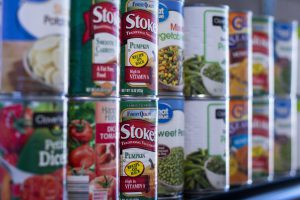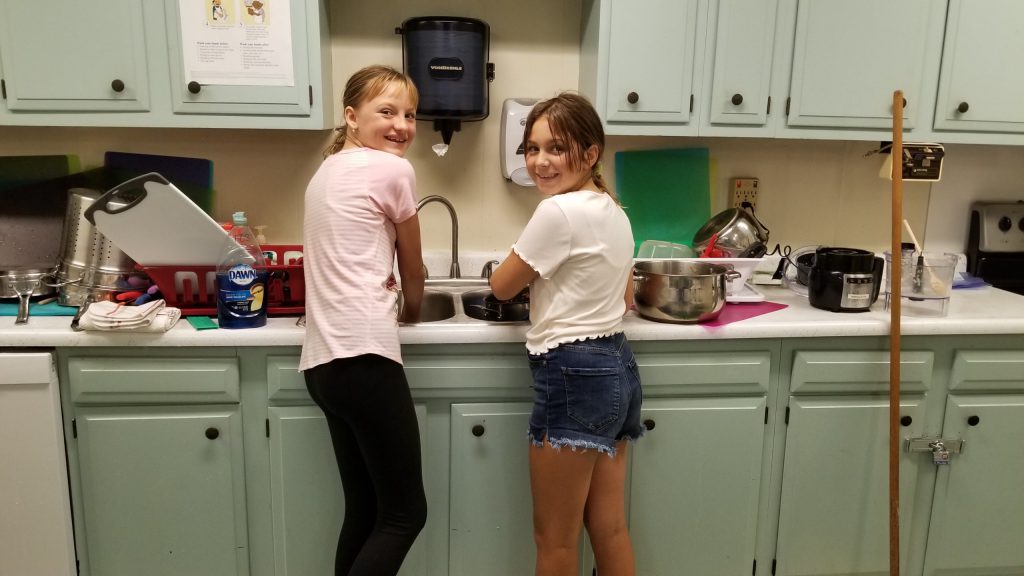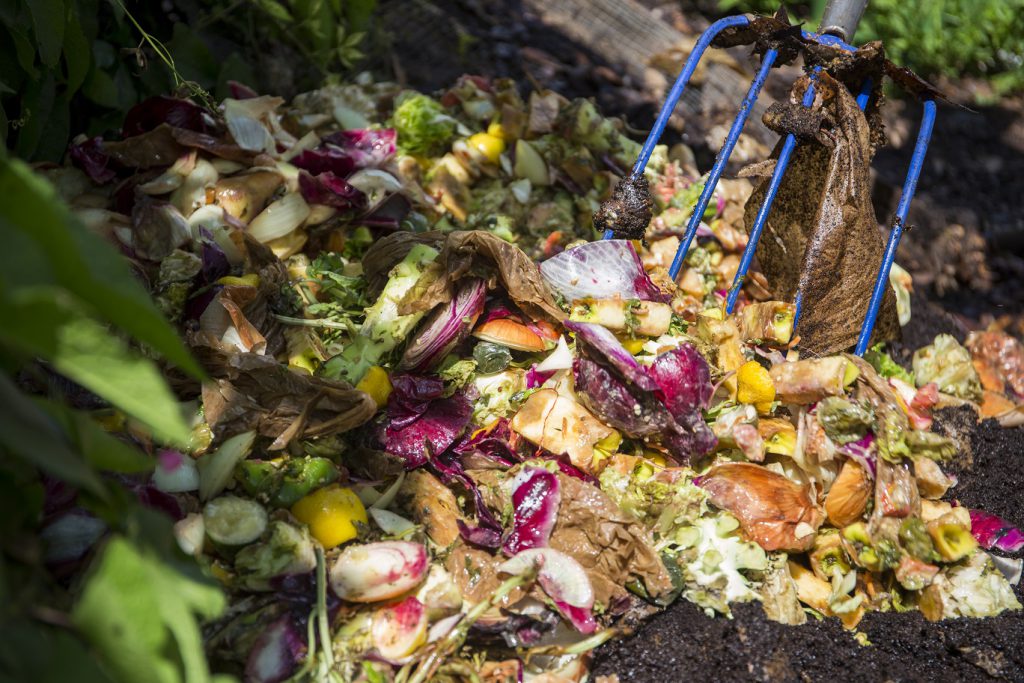


Preparing for the Storm – What’s for Dinner?

Stock up on canned fruits, vegetables, meats, and heat-and-eat soups for your hurricane food supply kit. Photo source: UF/IFAS Photo by Tyler Jones.
Now that we are officially in Hurricane Season (June1-November 30) and named storms are paying a call to the Sunshine State, it’s time to make sure we are prepared.
At the top of the list is planning meals for you and your family. Many people grab snack-type foods, such as crackers, cookies, and chips, or whatever is available on store shelves when the storm is approaching without having a meal plan in mind. Use MyPlate as a guide to plan meals to include fruits, vegetables, whole grains, protein, and dairy products. Foods from each food group provide important vitamins, minerals, and other nutrients to properly fuel your body so you are better equipped to deal with the challenges and stresses that accompany hurricanes and other disasters.
Plan a two-week supply of nonperishable or canned food and juices that require little or no cooking and no refrigeration. Include healthy snacks and any special foods for infants, senior adults, or persons with specific dietary needs. Select foods your family likes and will eat. Plan meals and shop early before a storm is on the horizon so you have a greater food selection and can take advantage of sales to stock up at a reduced cost. Keep planned written menus that have worked well for you and your family inside your hurricane food supply kit in a re-sealable plastic bag.
Brenda Marty-Jimenez, Family and Consumer Sciences Agent with UF/IFAS Extension Broward County, offers the following menu suggestions:
Breakfast Ideas
Apple juice • ready-to-eat cereal • small boxes of raisins • breakfast bars with fruit • shelf-stable skim milk • tea or instant coffee • water
Orange juice • hot cereal/instant oatmeal • banana • muffin • shelf-stable skim milk • tea or instant coffee • water
Grape juice •ready-to-eat cereal • canned peaches • yogurt • bread with jam or jelly • shelf-stable skim milk • tea or instant coffee • water
Lunch Options
Chunky beef soup (ready-to-eat style that only needs heating) • crackers • carrot and celery sticks • nuts • fruit cups packed in water • vanilla wafers • shelf-stable skim milk • tea or instant coffee • water
Canned cream soup (ready-to-eat style that only needs heating) • tuna sandwich on whole-wheat bread • tomato slices • unsweetened applesauce • cookies • shelf-stable skim milk • tea or instant coffee • water
Canned chili with beans (ready-to-eat style that only needs heating) • dinner rolls with margarine or butter • broccoli florets • canned fruit • animal crackers • shelf-stable skim milk • tea or instant coffee • water
Dinner Suggestions
Canned meat or cheese ravioli • three-bean salad (canned) • fresh yellow apples • bread with margarine or butter • fat-free pudding cup • shelf-stable skim milk • tea or instant coffee • water
Egg-salad sandwich on whole-wheat bread • canned green beans • canned fruit • fat-free pudding cup • shelf-stable skim milk • tea or instant coffee • water
Mac and cheese • canned vegetable • fresh pears • dinner rolls with margarine or butter • cookies • shelf-stable skim milk • tea or instant coffee • water
Remember the four key food safety principles: Cook, Clean, Chill, and Separate.
- Use a food thermometer to check the internal temperature of cooked foods.
- Wash hands for 20 seconds with soap and water. Sanitize food preparation and cooking surfaces regularly.
- Put leftovers in sealed bags or shallow containers and pack on ice or store in the refrigerator if it is running on a generator. Dispose of food that has been at room temperature for more than two hours (one hour if the temperature is 90oF or above) or has an off-odor, color, or texture.
- Toss out food that has come in contact with contaminated flood water. Do not eat foods from dented, swollen, or corroded cans, even though the food may appear safe to eat.
For more hurricane meal planning ideas and tips, visit: http://blogs.ifas.ufl.edu/browardco/2020/06/01/hurricane-preparedness-meal-and-menu-planning/

Kids in the Kitchen
I have just wrapped up my three-day Kitchen Creations camp and am happy to report that it was a big hit with the campers. Each day had a different country theme. Day 1 was Italian, Day 2 was Mexican, and Day 3 was American. All the dishes the kids made, including dessert, represented that day’s country.
The recipes ranged from simple to more complex, allowing the kids to build on basic skills to learn more advanced ones. For some campers, boiling a pot of water was a daunting task. For others, they learned how to caramelize and julienne. The campers worked in teams to create two main dishes, a salad, and a dessert each day, which was shared with the entire group.
I am pleased to announce there were no leftovers. The kids either ate it all, or wanted to take their culinary creations home to share with their families. If that is not a testimony to the camp’s success, I do not know what is.
I also was impressed with the campers’ willingness to try new things. Many of them were skeptical about the vegetable lasagna we made on Day 1, but nearly all the kids were willing to at least give it a try. And just like the baked ziti, Caesar salad, and chocolate biscotti we made that day, there was nothing left at the end of the day.
Kitchen skills are essential for healthy living, and teaching kids how to cook when they are young provides a strong foundation upon which to continue to build.

Kids can be eager helpers in the kitchen, even when it comes to cleaning up. Photo source: Samantha Kennedy, UF/IFAS Extension
Kids are eager learners in the kitchen. All the campers in Kitchen Creations were enthusiastic and ready to learn. They were proud of their creations, wanted to learn new skills, and were excited to use new tools and practice using familiar ones.
It is understandable that some parents may be reluctant to have younger kids in the kitchen. Maybe they are wary of possible injury. Maybe they are just so busy they do not have time to teach and supervise their children in the kitchen. It is a hectic world out there! But I know from personal experience with Kitchen Creations camp that kids, especially those interested in cooking, are more trustworthy and less accident-prone in the kitchen than some might expect.
The campers in my cooking camp are between the ages of 10 and 12 and in the four summers I have offered it, I have had only a few minor mishaps. The campers are aware of possible dangers in the kitchen. Things are hot. Things are sharp. Things are heavy. They are very conscientious about safety and handling things the correct way.
Kids who cook grow into adults who cook. Cooking is an important life skill that will be useful through someone’s entire life. Whether it is a student putting together quick, healthy meals and snacks to help them study, a busy parent trying to balance the responsibilities of everyday life while planning and making nutritious meals for their family, or a doting grandparent making something special for their grandkids, cooking is vital and brings people together.
Cooking is life.
I encourage you to support the budding chefs in your life. Instead of turning them away, allow them to help. Taking the time to prepare a meal together and then sharing that meal with loved ones builds stronger relationships while teaching important skills for a successful life.
UF/IFAS is an Equal Opportunity Institution.

Edible Garbage
I would like to continue on the theme of reducing food waste by talking more specifically about ways to use food scraps effectively to prevent them from ending up in the landfill.
As I was thinking about this topic, I was reminded of a funny scene from the 1982 film Night Shift, where Michael Keaton’s character, Billy Blaze, says into his tape recorder, “Idea to eliminate garbage: edible paper. You see, you eat it, it’s gone. Eat it, it’s out of there. No garbage.” Think about how much less waste would go into our landfills if we could just eat paper!
It is the same concept for food waste. As much as 40% of food grown, processed, and transported in the United States will never be eaten, destined to end up in the landfill. That is literally thousands of tons of food wasted each year. But what if we could help reduce that amount?

Got leftover veggie scraps? Instead of throwing them away, save them for a delicious veggie soup.
(Photo source: UF/IFAS)
Here are two great ideas for using leftover food scraps instead of throwing them away.
Cook with them. Leftover vegetables are great ingredients for a simple and delicious soup. Simply take the leftovers, combine them with an aromatic base of onions, garlic, and celery, add a liquid such as stock or broth (or water and white wine), throw in a generous helping of herbs, and cook for about 25-30 minutes. Then use an immersion blender or food processor (or stand-up blender) to blend into a creamy soup. Any type of vegetable works for this type of soup, from greens and cauliflower to parsnips and sweet potatoes, which makes it an ideal way to use up those scraps.
Another great way to use vegetable scraps is to make homemade stock. Vegetable parts such as carrot ends and peels, celery ends and greens, corn cobs, pea pods, and all the other bits trimmed off during food preparation can be used to make stock. Not in the mood to make stock right away? No problem! Veggie scraps can be saved in a zippered bag and kept frozen for up to six months.
When the time comes, simply dump the scraps into a large stock pot (that is why it is called a stock pot!) or Dutch oven, fill the pot 3/4 of the way with water, bring to a boil and simmer for at least 30 minutes. (The longer it simmers, the richer the flavor.) Strain it all through a sieve. The remaining liquid is the stock. Fresh stock can be stored 3-5 days in the refrigerator or frozen up to three months. Here is a simple resource from Cornell University Extension on how to make vegetable stock from kitchen scraps. (Here is another one from Tasty.co.)
Hold on! There are still scraps left over. What about those? Well, that brings me to the second great way to use kitchen scraps.

Food waste such as vegetable scraps can be added to compost to create a nutrient-rich fertilizer for home gardens.
(Photo source: Tyler Jones, UF/IFAS)
Compost them. Creating compost at home takes a little work and perseverance, but it can certainly pay off in the home garden. Nutrient-rich compost can add oomph to flower beds and vegetable patches and turn any garden into a showcase.
Vegetable scraps are perfect additions to any compost pile. Any vegetable scraps can be added to compost. Just remember to remove the little stickers, as those are not compostable.
According to the Environmental Protection Agency (EPA), there are many benefits to compost. It enriches soil, helping retain moisture and suppress plant diseases and pests. It reduces the need for chemical fertilizers. And it encourages the production of beneficial bacteria and fungi that break down organic matter to create humus, a rich nutrient-filled material. These fact sheets (this one and this one) from UF/IFAS Extension are a wealth of information about home composting.
The reduction of unnecessary food waste begins with us, the consumers. By learning how to use those scraps in useful ways, such as cooking and composting, we can help eliminate the excess food waste filling our landfills.
UF/IFAS is an Equal Opportunity Institution.

Keep It Fresh, Keep It Safe
Spring has arrived. It is fresh produce season. The USDA Dietary Guidelines recommend that half your plate should be filled with fruits and vegetables. Select a rainbow of colorful fresh fruits and vegetables to enhance your diet.
There is a bountiful supply of fruits and vegetables during the Spring and Summer months. Grocery stores, famers markets, and backyard gardens abound with abundant supply of fresh produce.
Recently fresh produce has been linked to various outbreaks of foodborne illness. These problems are becoming more common and it is important as a consumer to know how to handle fresh produce safely.
Safe Produce Handling Tips
Purchasing
Purchase vegetables and fruits that look and smell fresh. Purchase only the amount you will use in a few days. Most vegetables and fruits with the exception of apples, potatoes, and citrus don’t store well for long periods of time.
Storing
Put produce away promptly. Most whole produce will keep best stored in perforated plastic bags in the refrigerator crisper drawer where the humidity is highest. Tomatoes and potatoes are two exceptions. Tomatoes taste better if stored at room temperature. Potatoes stay fresh longer if stored in a cool, dry, dark place. Cut produce should be stored in the refrigerator in covered containers. Bacteria can grow on cut surfaces of produce.
Washing
Rinse whole produce thoroughly under clean running tap water, just before you are ready to use. Do not wash fruits and vegetables with detergent. Scrub or rub as needed to remove surface contamination. Wash produce such as oranges and melons even if you don’t eat the rind or skin. When you cut into a fruit or vegetable, any bacteria that is on the surface can be transferred to the inner flesh. Check the label instructions on fresh bagged produce. For example; use by date, pre-washed, and ready to eat. Discard stored fruits and vegetables that appear moldy or smell musty.
It is essential to our health to preserve the nutrition that is found in fruits and vegetables. Fruits and vegetables contain an abundance of vitamins and minerals that the body needs to maintain optimal health. Following those easy safe produce tips can help preserve freshness and assure safe produce handling.

Reducing Food Waste
Food waste is a huge problem here in the United States. Here are a few incredible facts: Food is the most common solid source of waste in American landfills. Anywhere from 25-40% of food grown, processed, and transported in the US will never be eaten. Food waste harms the environment and results in a lot of wasted money.
Looking for ways to reduce food waste? Just follow these six tips.
Plan meals carefully. Only purchase what will be eaten in a reasonable amount of time, especially perishable items. Buying large quantities of fresh produce, dairy, and other perishables may seem like a time-saving practice. However, throwing spoiled food away not only wastes money, but also time, since the spoiled items need to be replaced during another trip to the market.

Instead of throwing old fruits and vegetables away, turn them into nutrient-rich compost to help your garden thrive. (Photo source: Camila Guillen, UF/IFAS)
Freeze or re-use food whenever possible. Not all food freezes well. However, fresh fruits and vegetables freeze quickly and easily when handled properly and can last in the freezer for months. Vegetable scraps are also great for making compost, which enriches the soil and can help support the growth of backyard gardens.
Look at the sell by/use by/best by dates on food products. Try to purchase items with the longest shelf-life (the latest date) available. If a product is close to its sell by date, be sure to use it or freeze it quickly. Keep in mind, however, that just because a product is past its use by date does not mean it is unsafe to eat. Take it on a case-by-case basis. If there is no mold, pests, off odors, off colors, or off textures, the product is safe to consume. This is especially true for dry, non-perishable items.
Store food properly. Storing foods at the wrong temperatures can speed up the spoilage process. Keep the refrigerator between 37 and 39 degrees Fahrenheit. Dry goods storage should ideally be around 50 degrees F, but since this is not realistic for most of us, just make sure dry goods are stored in a cool, dry place outside of direct sunlight.
Stay organized. Arrange items so that the oldest stuff is in front. This helps ensure it is used first. Always label frozen foods with the item name and date it was first frozen and use within 12 months whenever possible. Foods frozen for longer than a year start to diminish in flavor and texture. Old food also tends to attract pests, so making sure things are used efficiently can help eliminate the risk of insects and rodents.
Donate non-perishables to those in need. Food banks and other community organizations are always looking for food donations to help the hungry. Non-perishable foods that have not surpassed their use by/sell by dates are always welcome donations. Instead of trashing it, share it with someone less fortunate.
In most cases, food affected by flood damage or other disasters should be discarded for safety reasons. Better to be safe than sorry. However, everyday food waste is completely avoidable if a few simple rules are followed. The amount of food thrown away each year in the US is disheartening. When shopping, being a little more mindful of quantities and dates can help reduce overall food waste, saving both money and the environment.
Additional Resources:
National Center for Home Food Preservation (University of Georgia Extension)
Food Waste Resources (Kansas State University Extension)
UF/IFAS is an Equal Opportunity Institution.

